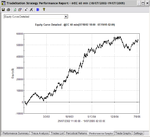Hi Paul,
Unfortunately the market is very choppy today. I took a loss with my real account too.
I am not comfortable trading without a stoploss because in the past I saw once my account almost vanishing in a less than a second after the trade went against me. Perhaps try a very wide s/l or stop and reverse.
Regards,
Dimi
Unfortunately the market is very choppy today. I took a loss with my real account too.
I am not comfortable trading without a stoploss because in the past I saw once my account almost vanishing in a less than a second after the trade went against me. Perhaps try a very wide s/l or stop and reverse.
Regards,
Dimi

